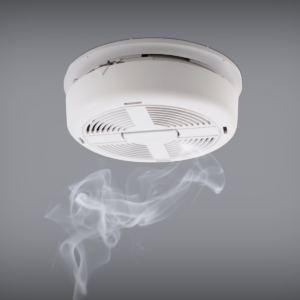
There are several types of smoke alarms available for residential use, but which type should you have in your home? Let’s take a look at smoke detector statistics and how they save lives and property; the different types of smoke alarms and how they work; and how you can keep your smoke detector in working condition with routine minor maintenance.
Smoke Detectors Save Lives and Property
Smoke detectors are an affordable resource and tool to alert a homeowner to a fire. A basic smoke detector can cost as little as $10, with the average cost at $25. This minimal investment can help save lives and protect property from extensive fire damage.
According to the National Fire Protection Agency (NFPA), working smoke detectors cut the risk of serious injury or death in a home fire by nearly 55%. Other interesting smoke detector statistics include:
- Smoke alarms were present in 74% of all reported home fires between 2014-2018.
- Nearly 3 out of 5 home fire deaths occurred in properties without a functional smoke detector.
- Missing or disconnected batteries are the main reason that a smoke detector fails. In fact, 41% of all failed smoke detectors were missing a power source.
- The most common reason someone disconnects a smoke alarm is a “nuisance” alert. This is when the smoke alarm is triggered by something other than a hazardous fire such as burnt food. In these cases, the smoke alarm is deactivated by the homeowner. If you deactivate a smoke alarm for a nuisance alert, always make sure it works properly after the nuisance has subsided.
Types of Smoke Detectors
There are three types of smoke detectors available for residential properties – ionization smoke detectors, photoelectric smoke detectors, and dual-sensor smoke detectors. While all three types will detect smoke, they work slightly differently.
- Ionization: Ionization smoke alarms have a small amount of radioactive material between two charged plates. The charged plates ionize the air and cause current to flow between the plates. During a fire, the smoke interrupts the current and sets off the alarm. Ionization smoke alarms tend to respond faster to smoke produced by flaming fires. Flaming fires ignite quickly, produce large flames, and tend to produce less smoke than a smoldering fire. Common causes of a flaming fire are combustibles that burn quickly such as gasoline and other flammable liquids; newspapers; cleaning products; and kitchen grease fires.
- Photoelectric: Photoelectric-type smoke detectors aim a light into a chamber at an angle away from the sensor. When smoke enters the chamber, it reflects light onto the light sensor and will trigger the alarm. Photoelectric smoke alarms respond faster to slow-burning smoldering fires. A smoldering fire can burn for hours and produces large amounts of smoke. Common causes of smoldering fires are cigarettes and cigars, electrical shorts, and fireplace embers.
- Dual Sensor: Dual sensor smoke detectors combine the technology of ionization and photoelectric to detect both flaming and smoldering fires.
Because it’s hard to predict the type of fire that may start in a home, and because every fire is different, the U.S. Fire Administration does not recommend one kind of smoke alarm over the other. Rather, it is recommended that every room where someone sleeps have either both kinds of smoke detectors or a dual sensor smoke alarm. In addition to having a smoke detector inside a bedroom, one should also be placed outside the bedroom in the hallway.
Smoke Alarm Installation & Maintenance
Even though smoke alarms are the easiest and most affordable way to protect yourself from injury during a home fire, they are often overlooked and forgotten. According to the NFPA, one out of five installed smoke alarms do not work properly. The sooner you hear a smoke alarm during a fire, the quicker you can get out of the home and call 911.
Here are some tips on installation and maintenance from the NFPA to ensure your smoke detectors are working properly:
- Install smoke alarms on every floor in your house, and both inside and outside every room where someone sleeps.
- Replace smoke alarms every 10 years. Like other electronics, smoke detectors have a finite lifespan. If you do not know the age of your current smoke detector, replace it.
- Changing your clocks? Change your smoke detector batteries.
- Test your smoke alarm at least once a month. Press the test button to be sure the alarm works properly.
- Gently vacuum or dust your smoke alarm monthly to prevent dirt from blocking the sensor.
- TV remote not working? Don’t steal the batteries from the smoke alarm for the remote. Always keep batteries in the smoke detector, and do not disable them for “nuisance” situations.
Working smoke detectors can prevent catastrophic property loss, and even more important, save lives. Once you have installed smoke detectors in your home, stay on top of the routine maintenance so they can alert you of a fire!
Fire Restoration Services in Harrisburg, Philadelphia, and Baltimore/DC Metro
While we hope you don’t need our fire restoration services, know that we are here to help. Our team of fire and smoke damage restoration professionals understands how stressful and tough a fire can be on a homeowner and their family. After a fire, not only are home contents destroyed by flames but there may also be water damage from emergency responders.
If you’ve experienced a home fire, let us help restore your home to its pre-loss condition if you are in Harrisburg, PA, Philadelphia, PA, or the Baltimore/DC Metro area. We are on-call 24/7 to help. Our services include fire and smoke damage restoration, water damage restoration, reconstruction, odor mitigation, and mold remediation. Let us help relieve the stress of the aftermath of a fire.

President of Reynolds Restoration Services. Over 20 years of experience in the emergency restoration industry.

